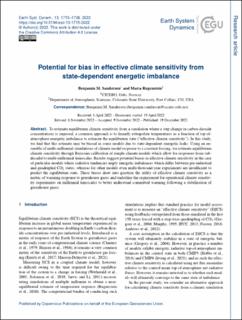| dc.contributor.author | Sanderson, Benjamin | |
| dc.contributor.author | Rugenstein, Maria | |
| dc.date.accessioned | 2024-02-15T12:39:49Z | |
| dc.date.available | 2024-02-15T12:39:49Z | |
| dc.date.created | 2023-01-15T15:10:16Z | |
| dc.date.issued | 2022 | |
| dc.identifier.citation | Earth System Dynamics. 2022, 13 (4), 1715-1736. | en_US |
| dc.identifier.issn | 2190-4979 | |
| dc.identifier.uri | https://hdl.handle.net/11250/3117984 | |
| dc.description.abstract | To estimate equilibrium climate sensitivity from a simulation where a step change in carbon dioxide concentrations is imposed, a common approach is to linearly extrapolate temperatures as a function of top-of-atmosphere energetic imbalance to estimate the equilibrium state (“effective climate sensitivity”). In this study, we find that this estimate may be biased in some models due to state-dependent energetic leaks. Using an ensemble of multi-millennial simulations of climate model response to a constant forcing, we estimate equilibrium climate sensitivity through Bayesian calibration of simple climate models which allow for responses from subdecadal to multi-millennial timescales. Results suggest potential biases in effective climate sensitivity in the case of particular models where radiative tendencies imply energetic imbalances which differ between pre-industrial and quadrupled CO2 states, whereas for other models even multi-thousand-year experiments are insufficient to predict the equilibrium state. These biases draw into question the utility of effective climate sensitivity as a metric of warming response to greenhouse gases and underline the requirement for operational climate sensitivity experiments on millennial timescales to better understand committed warming following a stabilization of greenhouse gases. | en_US |
| dc.language.iso | eng | en_US |
| dc.publisher | EGU | en_US |
| dc.rights | Navngivelse 4.0 Internasjonal | * |
| dc.rights.uri | http://creativecommons.org/licenses/by/4.0/deed.no | * |
| dc.title | Potential for bias in effective climate sensitivity from state-dependent energetic imbalance | en_US |
| dc.title.alternative | Potential for bias in effective climate sensitivity from state-dependent energetic imbalance | en_US |
| dc.type | Peer reviewed | en_US |
| dc.type | Journal article | en_US |
| dc.description.version | publishedVersion | en_US |
| dc.source.pagenumber | 1715-1736 | en_US |
| dc.source.volume | 13 | en_US |
| dc.source.journal | Earth System Dynamics | en_US |
| dc.source.issue | 4 | en_US |
| dc.identifier.doi | 10.5194/esd-13-1715-2022 | |
| dc.identifier.cristin | 2107117 | |
| dc.relation.project | EC/H2020/101003536 | en_US |
| dc.relation.project | EC/H2020/821003 | en_US |
| dc.relation.project | EC/H2020/101003687 | en_US |
| cristin.ispublished | true | |
| cristin.fulltext | original | |
| cristin.qualitycode | 1 | |

